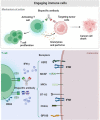Bispecific Antibodies Progression in Malignant Melanoma
- PMID: 35401191
- PMCID: PMC8984188
- DOI: 10.3389/fphar.2022.837889
Bispecific Antibodies Progression in Malignant Melanoma
Abstract
The discovery of oncogenes and immune checkpoints has revolutionized the treatment of melanoma in the past 10 years. However, the current PD-L1 checkpoints lack specificity for tumors and target normal cells expressing PD-L1, thus reducing the efficacy on malignant melanoma and increasing the side effects. In addition, the treatment options for primary or secondary drug-resistant melanoma are limited. Bispecific antibodies bind tumor cells and immune cells by simultaneously targeting two antigens, enhancing the anti-tumor targeting effect and cytotoxicity and reducing drug-resistance in malignant melanoma, thus representing an emerging strategy to improve the clinical efficacy. This review focused on the treatment of malignant melanoma by bispecific antibodies and summarized the effective results of the experiments that have been conducted, also discussing the different aspects of these therapies. The role of the melanoma epitopes, immune cell activation, cell death and cytotoxicity induced by bispecific antibodies were evaluated in the clinical or preclinical stage, as these therapies appear to be the most suitable in the treatment of malignant melanoma.
Keywords: bispecific antibody; cytotoxicity; immunotherapy; intracellular target; melanoma.
Copyright © 2022 Tang, Gong and Ma.
Conflict of interest statement
The authors declare that the research was conducted in the absence of any commercial or financial relationships that could be construed as a potential conflict of interest.
Figures




Similar articles
-
Bispecific Antibody Approach for Improved Melanoma-Selective PD-L1 Immune Checkpoint Blockade.J Invest Dermatol. 2019 Nov;139(11):2343-2351.e3. doi: 10.1016/j.jid.2019.01.038. Epub 2019 May 23. J Invest Dermatol. 2019. PMID: 31128201
-
Generation of a safe and efficacious llama single-domain antibody fragment (vHH) targeting the membrane-proximal region of 4-1BB for engineering therapeutic bispecific antibodies for cancer.J Immunother Cancer. 2021 Jun;9(6):e002131. doi: 10.1136/jitc-2020-002131. J Immunother Cancer. 2021. PMID: 34172514 Free PMC article.
-
The construction, expression, and enhanced anti-tumor activity of YM101: a bispecific antibody simultaneously targeting TGF-β and PD-L1.J Hematol Oncol. 2021 Feb 16;14(1):27. doi: 10.1186/s13045-021-01045-x. J Hematol Oncol. 2021. PMID: 33593403 Free PMC article.
-
Bispecific antibodies in cancer immunotherapy.Ther Adv Vaccines Immunother. 2018 Feb;6(1):3-17. doi: 10.1177/2515135518763280. Epub 2018 Mar 28. Ther Adv Vaccines Immunother. 2018. PMID: 29998217 Free PMC article. Review.
-
The Next Immune-Checkpoint Inhibitors: PD-1/PD-L1 Blockade in Melanoma.Clin Ther. 2015 Apr 1;37(4):764-82. doi: 10.1016/j.clinthera.2015.02.018. Epub 2015 Mar 29. Clin Ther. 2015. PMID: 25823918 Free PMC article. Review.
Cited by
-
Advances in Cell and Immune Therapies for Melanoma.Biomedicines. 2025 Jan 3;13(1):98. doi: 10.3390/biomedicines13010098. Biomedicines. 2025. PMID: 39857682 Free PMC article. Review.
-
Advancing immunotherapy for melanoma: the critical role of single-cell analysis in identifying predictive biomarkers.Front Immunol. 2024 Jul 4;15:1435187. doi: 10.3389/fimmu.2024.1435187. eCollection 2024. Front Immunol. 2024. PMID: 39026661 Free PMC article. Review.
-
Chemotherapy efficacy in advanced melanoma patients after failure of immune checkpoint and BRAF/MEK inhibitors.Contemp Oncol (Pozn). 2025;29(2):165-170. doi: 10.5114/wo.2025.150451. Epub 2025 May 9. Contemp Oncol (Pozn). 2025. PMID: 40620891 Free PMC article.
-
Advancements and Challenges in Personalized Therapy for BRAF-Mutant Melanoma: A Comprehensive Review.J Clin Med. 2024 Sep 12;13(18):5409. doi: 10.3390/jcm13185409. J Clin Med. 2024. PMID: 39336897 Free PMC article. Review.
References
Publication types
LinkOut - more resources
Full Text Sources
Other Literature Sources
Research Materials
Miscellaneous

